Unit 3 Sea Exploration Using Language (Listening and Speaking)课件(共15张PPT,内镶嵌音频)2024-2025学年高二英语人教版 选
文档属性
| 名称 | Unit 3 Sea Exploration Using Language (Listening and Speaking)课件(共15张PPT,内镶嵌音频)2024-2025学年高二英语人教版 选 | 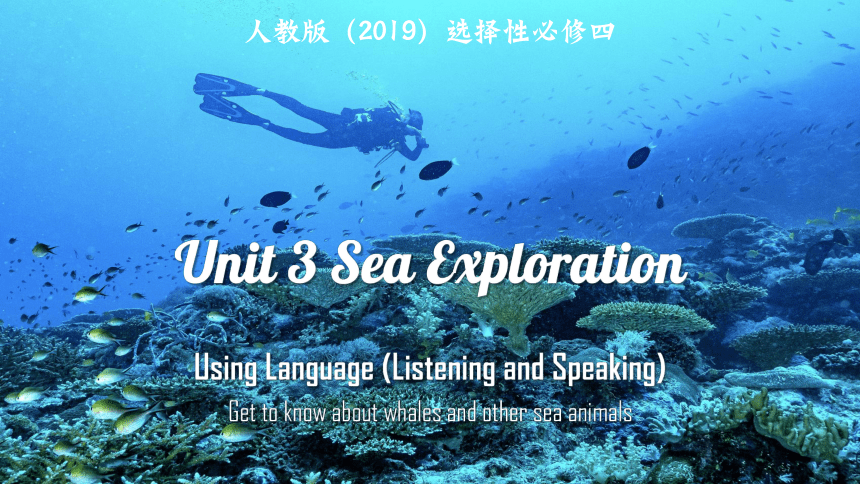 | |
| 格式 | pptx | ||
| 文件大小 | 40.6MB | ||
| 资源类型 | 教案 | ||
| 版本资源 | 人教版(2019) | ||
| 科目 | 英语 | ||
| 更新时间 | 2025-05-09 10:57:19 | ||
图片预览

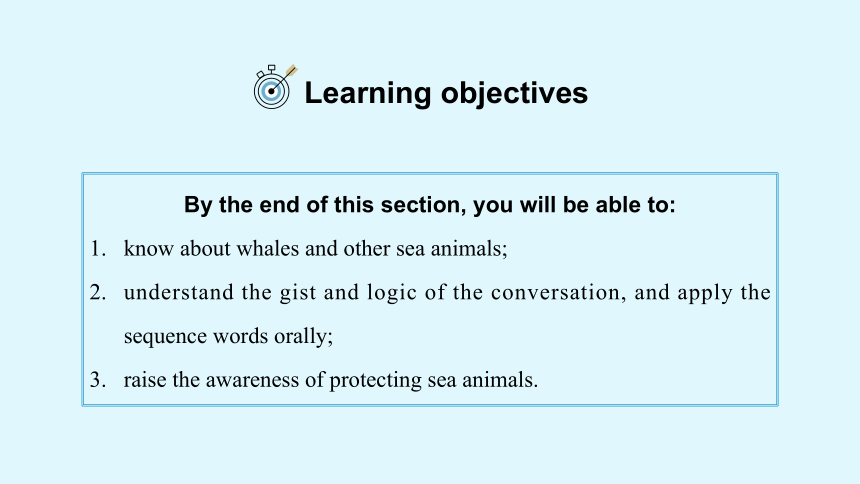
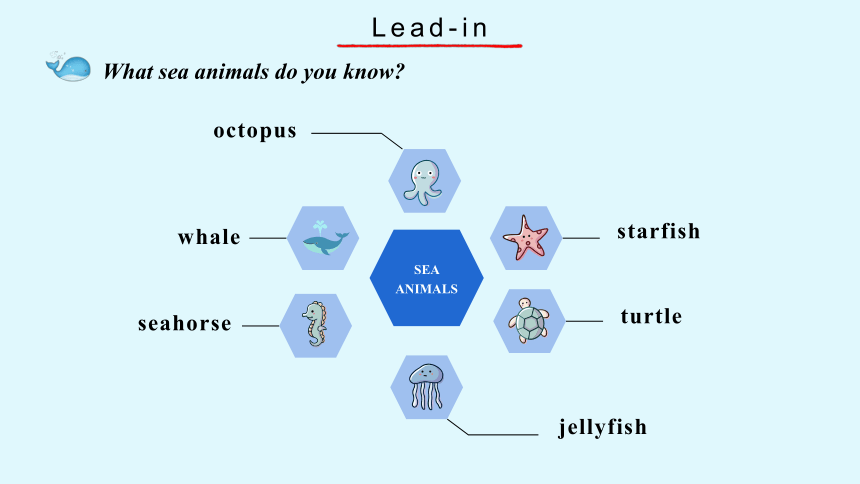
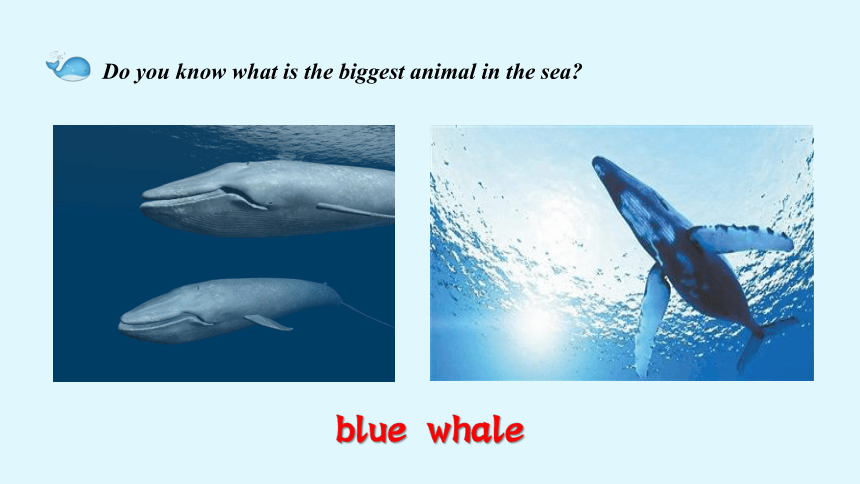
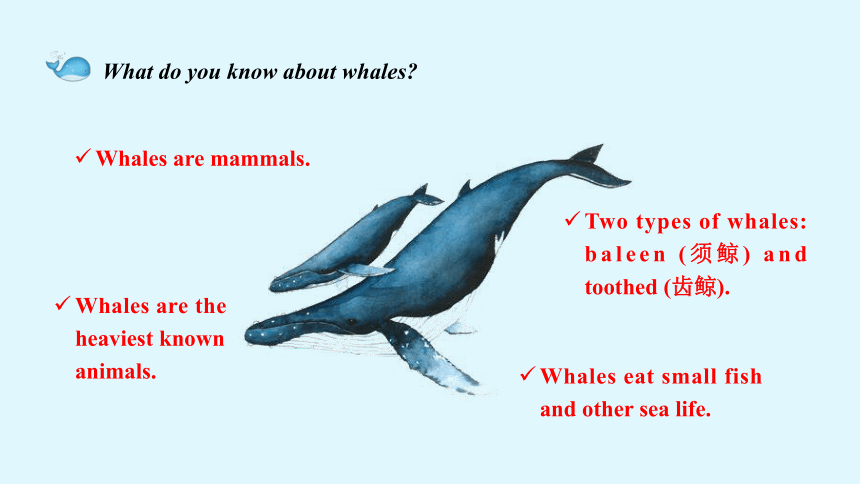
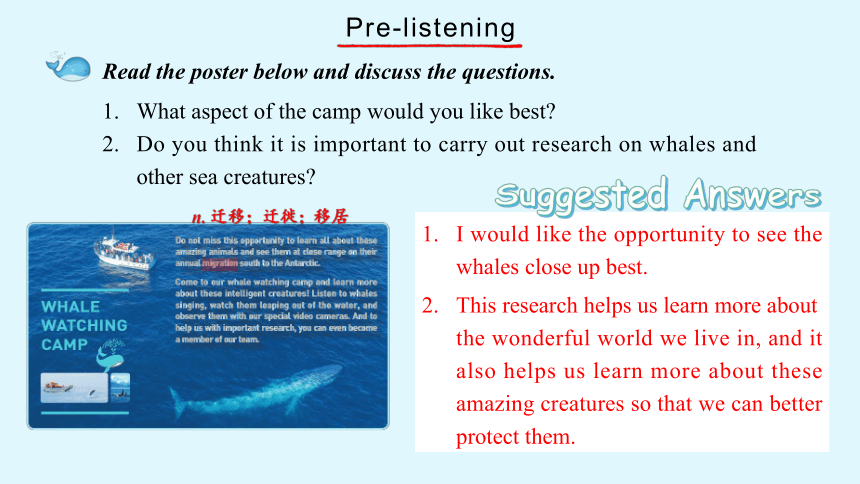
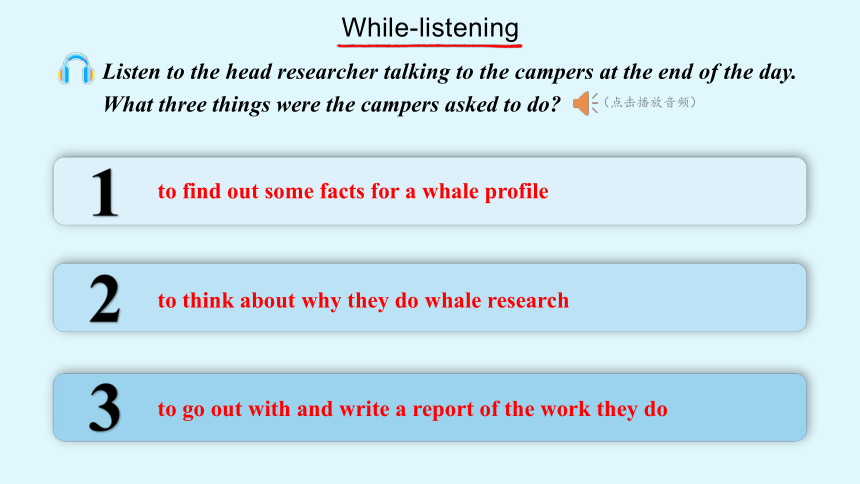
文档简介
(共15张PPT)
人教版(2019)选择性必修四
Unit 3 Sea Exploration
Using Language (Listening and Speaking)
Get to know about whales and other sea animals
Learning objectives
By the end of this section, you will be able to:
know about whales and other sea animals;
understand the gist and logic of the conversation, and apply the sequence words orally;
raise the awareness of protecting sea animals.
SEA ANIMALS
octopus
starfish
turtle
jellyfish
seahorse
whale
Lead-in
What sea animals do you know
Do you know what is the biggest animal in the sea
blue whale
What do you know about whales
Whales are mammals.
Whales are the heaviest known animals.
Two types of whales: baleen (须鲸) and toothed (齿鲸).
Whales eat small fish and other sea life.
I would like the opportunity to see the whales close up best.
This research helps us learn more about the wonderful world we live in, and it also helps us learn more about these amazing creatures so that we can better protect them.
What aspect of the camp would you like best
Do you think it is important to carry out research on whales and other sea creatures
Suggested Answers
Pre-listening
Read the poster below and discuss the questions.
n. 迁移;迁徙;移居
While-listening
Listen to the head researcher talking to the campers at the end of the day. What three things were the campers asked to do
(点击播放音频)
1
2
3
to find out some facts for a whale profile
to think about why they do whale research
to go out with and write a report of the work they do
Listen to Luke’s part of the conversation again. Number the following sentences in the correct order. Then work out what they have done at the camp.
Listen for sequence
When people talk about a series of actions or events happening in sequence of time, they often use certain words and phrases, such as first, next, then, after that, later, and finally.
2
3
4
5
6
7
8
(点击播放音频)
n. 名录;电话号码簿;(计算机文件或程序的)目录
adv. 与此同时;(比较两方面)对比之下
Over 80.
The criterion is whether they have teeth or not.
They use sounds to communicate and hunt.
This can help them to tell the whales apart.
They want to share information with them.
How many species of whales are there
What is the criterion to divide the main types of whales
What do whales use sounds for
Why do the campers take pictures of the whales’ fins
Why do they contact other research groups
Suggested Answers
Listen to the conversation again and answer the questions.
(点击播放音频)
Listen to the conversation again and fill in the blanks.
Craig: Here at the camp we are ____ about whales! Today you have been helping us with our whale research. First of all, we asked you
to find out some facts for a whale _______. What did you find, Sally
Sally: There are over 80 different species of whales. These include the blue whale, the ______ known animal to have ever existed. They
can grow to 100 feet long, and can _____ nearly 200 tons! There are two ____ types of whale: those with teeth, and those without.
Those without teeth eat very small organisms, whereas those with teeth eat fish and other larger sea animals. More than 70
species of whales have teeth.
Craig: Great! Then, we asked you to think about why we do whale research. Yes, Ben.
Ben: Firstly, it is to _______ how many whales there are. Whales are threatened by many ______, including climate change, ________,
and hunting. Secondly, it is to track where whales go, so we can understand more about them, like their life cycle. Lastly, we
know that whales are very _________. They communicate and hunt using complex sounds, and even sing and share songs. They
can learn by themselves and can _____ the things they have learnt to their young. We want to understand more about this.
Craig: Very good, Ben. And lastly, we asked you to go out with us and write a report of the work we do. Can you give us your report,
Luke
Luke: Yes. First, we followed a group of whales with the boat. Then we took pictures of their fins. Most whales have ________ different
fins and marks, which can help us to tell them apart. Meanwhile, we also noted their location, so we can track their movements
and plot their ________ path. Later, we created a database of their fins and locations. After that, we gave the group of whales a
name, and each member a number. They will be added to the directory so we can ________ them in the future. Finally, we
________ other whale research groups around the world to share the information with them.
Craig: Excellent! Thank you all for your help today.
wild
profile
largest
weigh
main
monitor
factors
pollution
intelligent
teach
slightly
migration
identify
contacted
(点击播放音频)
Whales
(over 80 species)
Whales
with teeth
Whales
without teeth
Food
Species
Food
Typical species
fish, sea animals
70
small organisms
blue whale
Length
Weight
100 feet
200 tons
Post-listening
Read the transcript, and complete the following mind map about whales.
First(ly), ... Second(ly), ... Third(ly), ... First of all, ...
Then / After that / Afterwards / Next / Later on ...
In the end / At last, ... At that time ...
It began when ... Meanwhile ... Later ... Finally ...
Expressing sequence
EXAMPLE
A: Today we learnt about whales and whale research. First, we found some information and facts about
whales. We used the library and the Internet.
B: What did you do after that
...
Some of the students could not make it to the camp. Imagine you were there. Tell your partner about what happened, using the expressions in the box below. Your partner can also ask questions to find out more about what happened.
A: Today we learnt about whales and whale research. First, we found some information and facts about whales. We used
the library and the Internet.
B: What did you do after that
A: Well, after that we thought about why we do whale research.
B: But why do we do whale research
A: There are lots of reasons. First of all, we need to know how many whales there are. Then, we need to know where they
go. And finally, we need to understand more about them.
B: Then what did you do next
A: After that, we went out whale watching, following a group of whales in a boat.
B: That sounds neat. Did you just watch them, or did you do anything else
A: We started by taking pictures of their fins, so we could tell them apart. At the same time, we noted their location, so we
could track them.
B: What did you do afterwards
A: We created a database and gave each whale a name and number. Then finally, we shared our information with other
whale research groups around the world.
B: It all sounds so wonderful! I wish I could have joined you.
A: I do, too.
Suggested Dialogue
What sea animals can you see in the video
What other sea animals would you like to see
What would you like to know about these sea animals
Watch the video Protecting Biodiversity, and then discuss what other sea animals you would like to see. Talk with your partner and make a plan for a trip to see the animals. Your plan should include activities you would like to do.
(点击播放视频)
Homework
Choose one of sea animals and make plans to protect it. Then use some expressions about sequence to introduce your plan.
人教版(2019)选择性必修四
Unit 3 Sea Exploration
Using Language (Listening and Speaking)
Get to know about whales and other sea animals
Learning objectives
By the end of this section, you will be able to:
know about whales and other sea animals;
understand the gist and logic of the conversation, and apply the sequence words orally;
raise the awareness of protecting sea animals.
SEA ANIMALS
octopus
starfish
turtle
jellyfish
seahorse
whale
Lead-in
What sea animals do you know
Do you know what is the biggest animal in the sea
blue whale
What do you know about whales
Whales are mammals.
Whales are the heaviest known animals.
Two types of whales: baleen (须鲸) and toothed (齿鲸).
Whales eat small fish and other sea life.
I would like the opportunity to see the whales close up best.
This research helps us learn more about the wonderful world we live in, and it also helps us learn more about these amazing creatures so that we can better protect them.
What aspect of the camp would you like best
Do you think it is important to carry out research on whales and other sea creatures
Suggested Answers
Pre-listening
Read the poster below and discuss the questions.
n. 迁移;迁徙;移居
While-listening
Listen to the head researcher talking to the campers at the end of the day. What three things were the campers asked to do
(点击播放音频)
1
2
3
to find out some facts for a whale profile
to think about why they do whale research
to go out with and write a report of the work they do
Listen to Luke’s part of the conversation again. Number the following sentences in the correct order. Then work out what they have done at the camp.
Listen for sequence
When people talk about a series of actions or events happening in sequence of time, they often use certain words and phrases, such as first, next, then, after that, later, and finally.
2
3
4
5
6
7
8
(点击播放音频)
n. 名录;电话号码簿;(计算机文件或程序的)目录
adv. 与此同时;(比较两方面)对比之下
Over 80.
The criterion is whether they have teeth or not.
They use sounds to communicate and hunt.
This can help them to tell the whales apart.
They want to share information with them.
How many species of whales are there
What is the criterion to divide the main types of whales
What do whales use sounds for
Why do the campers take pictures of the whales’ fins
Why do they contact other research groups
Suggested Answers
Listen to the conversation again and answer the questions.
(点击播放音频)
Listen to the conversation again and fill in the blanks.
Craig: Here at the camp we are ____ about whales! Today you have been helping us with our whale research. First of all, we asked you
to find out some facts for a whale _______. What did you find, Sally
Sally: There are over 80 different species of whales. These include the blue whale, the ______ known animal to have ever existed. They
can grow to 100 feet long, and can _____ nearly 200 tons! There are two ____ types of whale: those with teeth, and those without.
Those without teeth eat very small organisms, whereas those with teeth eat fish and other larger sea animals. More than 70
species of whales have teeth.
Craig: Great! Then, we asked you to think about why we do whale research. Yes, Ben.
Ben: Firstly, it is to _______ how many whales there are. Whales are threatened by many ______, including climate change, ________,
and hunting. Secondly, it is to track where whales go, so we can understand more about them, like their life cycle. Lastly, we
know that whales are very _________. They communicate and hunt using complex sounds, and even sing and share songs. They
can learn by themselves and can _____ the things they have learnt to their young. We want to understand more about this.
Craig: Very good, Ben. And lastly, we asked you to go out with us and write a report of the work we do. Can you give us your report,
Luke
Luke: Yes. First, we followed a group of whales with the boat. Then we took pictures of their fins. Most whales have ________ different
fins and marks, which can help us to tell them apart. Meanwhile, we also noted their location, so we can track their movements
and plot their ________ path. Later, we created a database of their fins and locations. After that, we gave the group of whales a
name, and each member a number. They will be added to the directory so we can ________ them in the future. Finally, we
________ other whale research groups around the world to share the information with them.
Craig: Excellent! Thank you all for your help today.
wild
profile
largest
weigh
main
monitor
factors
pollution
intelligent
teach
slightly
migration
identify
contacted
(点击播放音频)
Whales
(over 80 species)
Whales
with teeth
Whales
without teeth
Food
Species
Food
Typical species
fish, sea animals
70
small organisms
blue whale
Length
Weight
100 feet
200 tons
Post-listening
Read the transcript, and complete the following mind map about whales.
First(ly), ... Second(ly), ... Third(ly), ... First of all, ...
Then / After that / Afterwards / Next / Later on ...
In the end / At last, ... At that time ...
It began when ... Meanwhile ... Later ... Finally ...
Expressing sequence
EXAMPLE
A: Today we learnt about whales and whale research. First, we found some information and facts about
whales. We used the library and the Internet.
B: What did you do after that
...
Some of the students could not make it to the camp. Imagine you were there. Tell your partner about what happened, using the expressions in the box below. Your partner can also ask questions to find out more about what happened.
A: Today we learnt about whales and whale research. First, we found some information and facts about whales. We used
the library and the Internet.
B: What did you do after that
A: Well, after that we thought about why we do whale research.
B: But why do we do whale research
A: There are lots of reasons. First of all, we need to know how many whales there are. Then, we need to know where they
go. And finally, we need to understand more about them.
B: Then what did you do next
A: After that, we went out whale watching, following a group of whales in a boat.
B: That sounds neat. Did you just watch them, or did you do anything else
A: We started by taking pictures of their fins, so we could tell them apart. At the same time, we noted their location, so we
could track them.
B: What did you do afterwards
A: We created a database and gave each whale a name and number. Then finally, we shared our information with other
whale research groups around the world.
B: It all sounds so wonderful! I wish I could have joined you.
A: I do, too.
Suggested Dialogue
What sea animals can you see in the video
What other sea animals would you like to see
What would you like to know about these sea animals
Watch the video Protecting Biodiversity, and then discuss what other sea animals you would like to see. Talk with your partner and make a plan for a trip to see the animals. Your plan should include activities you would like to do.
(点击播放视频)
Homework
Choose one of sea animals and make plans to protect it. Then use some expressions about sequence to introduce your plan.
